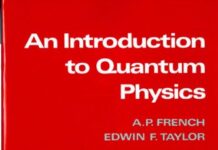
Ebook Info
- Published: 2017
- Number of pages: 326 pages
- Format: PDF
- File Size: 27.91 MB
- Authors: A.P. French
Description
The M.I.T. Introductory Physics Series is the result of a program of careful study, planning, and development that began in 1960. The Education Research Center at the Massachusetts Institute of Technology (formerly the Science Teaching Center) was established to study the process of instruction, aids thereto, and the learning process itself, with special reference to science teaching at the university level. Generous support from a number of foundations provided the means for assembling and maintaining an experienced staff to co-operate with members of the Institute’s Physics Department in the examination, improvement, and development of physics curriculum materials for students planning careers in the sciences. After careful analysis of objectives and the problems involved, preliminary versions of textbooks were prepared, tested through classroom use at M.I.T. and other institutions, re-evaluated, rewritten, and tried again. Only then were the final manuscripts undertaken.
User’s Reviews
Reviews from Amazon users which were colected at the time this book was published on the website:
⭐Oscillatory function is at the root of all natural phenomena. Comprehending this behavior as a mathematically pure process is a basis through which countless aspects of the sciences and the arts can be explained, described, and even creatively elaborated upon. The effects of the physical manifestation of waves, and the inevitable complexities resulting from their interaction with the environment, are essential considerations as well.The pages of this work are information-dense, providing physical, geometric, and mathematical descriptions of vibrations. Introducing the sine-wave, vectors and complex-exponentials as the fundamentals of periodic motion, the topics then progress to combining vibrations, masses and springs, harmonic and torsional oscillation, forced vibrations, coupled oscillators, Fourier analysis, orthogonal functions, energy transporting, decay of free vibrations, nuclear and optical resonance, diffraction and inference patterns to briefly name but a few. Physical considerations and methods are discussed in detail as well, and exercises at the end of each chapter indicate what the reader is expected to have extracted from each section [selected answers are provided].The text within each section is written in an extremely clear, systematic and enthusiastic manner and speaks to an intelligent, inquisitive beginner of the subject matter. The numerous excellent black-and-white illustrations diagrams and photographs supplement the written descriptions admirably. The typefaces and even the feel of the paper of the book are high quality and elegant.This is an introductory work regarding oscillatory analysis, however some mathematical knowledge is assumed by implication. Within the first 15 pages alone are equations which include derivatives, vectors, polar coordinates, complex numbers, and infinite series. It is probably best treated as a supplementary work to an on-going effort in mathematics, the natural sciences, or engineering. Essentially a good foundation in calculus should be sufficient. Given such background so as to understand the crucial mathematics, this work provides an incredible array and range of topics. The preface indicates that this series, by MIT Press, was established to assist in the educational process specifically, and it was tested and evaluated with this objective. As such this book is inherently a supplementary work, and prepares the reader for further research in and comprehension of an incredible range of subjects. Quantum physics, music, human movement, engineering disciplines, the natural sciences, astronomy and more have oscillation as a common thread and basis of understanding. The mechanics of the vibrational processes underlying all of these are elaborated upon to an amazing level of detail and precision within this work.This book gets my highest recommendation for the focused subject matter it so eloquently and successfully discusses.
⭐I think the majority of the raving reviews are from professors that have lost touch with what it is like to be learning the material for the first time. There are a lot of assumptions of knowledge that is taken for granted. This is much better than most text books as it does not needlessly go into several pages of equations to explain a concept, words and the critical parts of the derivations are used. The equations flow nicely without skipping the critical steps for understanding. Examples would be nice. Another reviewer mentioned the MIT Open Courseware and another site for examples and solutions. You definitely need a solid calculus and differential equations understanding to follow along. If you were unfortunate enough to get apathetic graduate student instruction for those courses, you will be in a world of hurt.The paperback is an illegal copy from India. You can see wrinkles and folds in the pages, yet the pages are smooth. Some pages have smudges while others have debris printed on them. Everything is readable, so it seems that they have improved the scanning/printing quality from earlier reviews. The copy page states that it has been published in India by arrangement with W.W. Norton & Co, which I am assuming is the original publisher, but there is a piece of black tape over the words “Sales area: India only”.I’m not really complaining as the book was under $15, but it would have been nice to know what I was getting beforehand (I didn’t read the reviews as it was required for part of a course) and I’m sure this violates Amazon’s sales policies.
⭐I used this book instead of the originally assigned text (H.J. Pain’s truly awful “Physics of Vibrations and Waves”) in a class I took recently. It was a pleasure to read.In spite of the fact that the book is quite short (and quite compact in your bag), it covers the material very thoroughly. The author writes clearly and with a lot of attention to the needs of the student. French’s style is also very lively and makes you want to read on instead of feeling you are obligated to. The problems at the end of each chapter are excellent. It is also inexpensive.All in all, quite a gem in this day of boring, incomprehensible, too-heavy-to-carry $120 textbooks that arrive in a “new” less readable edition every year. If only every textbook could be like this.It isn’t quite perfect — every once in a while a derivation gets obscure and a few topics aren’t covered — but it is very, very good. I highly recommend it.
⭐A book on waves
⭐Book was in good condition, but this paperback design doesn’t like to sit open, so it’s difficult to have the book propped while you try to work through problems. This book teaches physics like a story; a change from what I’m used to where important equations are highlighted for the sake of studying.
⭐Would give it five stars for the actual content inside it, this book is a excellent, a classic on basic physics of waves and oscillations. But the copy I received looks like a poor scan from the original 1970’s issue (which my local university library has a copy, and I believe it IS a scan). The text is skewed, some pages are washed out or have black stains, and some pictures illustrating the phenomena are impossible to understand. If I knew this I would have scanned the old original book myself.
⭐A. P. French is a real Teacher, with a capital “T”.This book is part of the MIT Introductory Physics series that has three other titles by the same outstanding author: “Newtonian Mechanics”, “Special Relativity” and “An Introduction to Quantum Physics” (coauthored with E. F. Taylor, yes the Taylor of Wheeler and Taylor’s “Spacetime Physics”). A set of books that combine clarity of exposition with historical notes on the development of physics.One might be put off by the fact this book is more than forty years old. Don’t! This is a little gem of clarity and synthesis that stood the test of time. It actually goes to the roots of the physical principles of the oscillatory motion and does not give anything for granted. Yes, the main emphasis is on the oscillations of mechanical systems, but this is not necessarily a con. As a matter of fact, it helps the reader to develop a more intuitive view of the phenomena described while they can still be translated into other domain’s by means of physical analogies.This book is a must have.One note on the publisher: be warned that the latest paperback editions by Norton look like xeroxes of the original book: the pictures with the gray background show bands and dithering as if they had been scanned at very low resolution with a cheap scanner. If you can, find a used copy of the old hardbound edition. The ‘old days’ quality is much much better than today’s standard.
⭐A concise book meant for early undergraduates – no mathematics beyond basic calculus is assumed, all the derivations are clearly shown. Especially good is a thorough discussion of the complex numbers and their utilisation in the harmonic oscillator (and related) problems.A great thing is including a lot of pictures of experiments exhibiting the phenomena being discussed (if only to make one look them up on youtube).The book also includes a short (but great) section on Fourier Analysis – not a thorough treatment, but being familiar with this physical interpretation of FA (modes of a vibrating string) proved useful when I started a FA course later.A wealth of exercises with solutions is included.Also, the Indian copy is really bad – the pages are so thin the ink on the other side is visible. This is a shame as the pictures are sometimes almost undecipherable.
⭐Honestly speaking , this book could overwhelm you a bit in the beginning if you have not revised your 12th Mechanics and Geometry , but don’t give up on this book. It is brilliantly written and mainly focuses on the theoretical concepts of vibration physics. One piece of advice from me is that DONT BUY FOR JEE OR NEET. This book is strictly for Bsc Physics or your Engineering courses. So no need to rack you brain over this book just for a small easy chapter of SHM , any general physics text is more than enough. The binding or the printing quality could use a lot of work , it rather looks like cheap photocopy of the pdf version. Some of the diagrams labelling are not quite visible clearly and often required me to refer to the pdf version. But rest assured the content is top-notch. It may require a few weeks to get accustomed to the writing styles and the geometry used but once you get the hang of it , it becomes straight forward enough.Anyways Happy Reading.If you find it helpful , be sure to hit the helpful button below.
⭐Rather poor quality printing of an otherwise excellent book.
⭐The book itself is ok, but takes time to read to gain any useful information unlike a quick textbook, it is well written however it is smudged on many pages and some of the ink has left some sentences hard to read.
Keywords
Free Download Vibrations and Waves 1st Edition in PDF format
Vibrations and Waves 1st Edition PDF Free Download
Download Vibrations and Waves 1st Edition 2017 PDF Free
Vibrations and Waves 1st Edition 2017 PDF Free Download
Download Vibrations and Waves 1st Edition PDF
Free Download Ebook Vibrations and Waves 1st Edition


